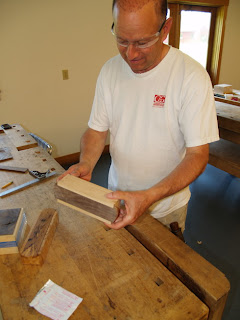I was also pleased to meet readers of the blog yesterday and even more on the day before. One, a 7th and 8th grade woodshop teacher from a Boston public school came up yesterday to ask about projects, and to get some inspiration for next year's classes. Like many other woodworking teachers, he had found boxes to be great and inspiring projects for both boys and girls, so he spent some time photographing boxes, sketching boxes and watching a couple demonstrations. Another blog reader is from Australia and is currently studying at the school as one of an elite group of advanced students in furniture design. It is a pleasure to connect faces with readers, and gives me both a better sense of the importance of this blog (without an inflated sense of self) and additional reason to keep at the writing of it, knowing there are real folks who understand the wisdom of their hands.

 I am gradually getting to know the school better and am taking advantage of occasional walk-throughs to see what other classes are up to. Silas Kopf is teaching marquetry, and his work is inspirational. In the twelve week intensive course, students are busy cutting through and half-blind dovetails.I could spend all my time here on the blog raving like a lunatic about the wonders I see, or about the pride I see taken in work, that I'm sorry too many don't find in their lives. But I also like to stick a bit to the subject at hand. And that is to find ways to get kids working with wood. It is certainly not enough that we find pleasure in woodworking ourselves and then let our children suffer in schools where they are deprived of opportunity to express their own creative inclinations. These inclinations can be freely and safely expressed to the benefit of human culture and each child.
I am gradually getting to know the school better and am taking advantage of occasional walk-throughs to see what other classes are up to. Silas Kopf is teaching marquetry, and his work is inspirational. In the twelve week intensive course, students are busy cutting through and half-blind dovetails.I could spend all my time here on the blog raving like a lunatic about the wonders I see, or about the pride I see taken in work, that I'm sorry too many don't find in their lives. But I also like to stick a bit to the subject at hand. And that is to find ways to get kids working with wood. It is certainly not enough that we find pleasure in woodworking ourselves and then let our children suffer in schools where they are deprived of opportunity to express their own creative inclinations. These inclinations can be freely and safely expressed to the benefit of human culture and each child.In his address delivered to the Eastern Manual Training Association in 1904, Gustaf Larsson noted that the pronciples of Educational Sloyd were based on observation of how children actually learn.
"PRINCIPLES OF SLOYD--
1. The teachers must be professional teachers, and not artisans merely.
2. The teaching must be systematic, progressive, and. with exception of certain class demonstrations, as far as possible, individual.
3. Such work should be selected as will give the best physical development, through free, vigorous movements.
4. The visible or material results should in even respect represent the workers' own effort. Generally speaking, this should mean no division of labor, and practically the exclusion of machinery as a labor-saving device.
5. The exercises, which progress from the easy to the more difficult, should be applied on attractive objects, the use of which can be thoroughly appreciated by the worker. Each object should be simple, and of good form and proportion.
6. The course should include not only objects which can be made accurate by the help of testing tools, but also free-hand work which exercises the sense of form through sight and touch.
7. Special importance is attached to neatness, accuracy, and finish, to the love of good work for its own sake, and to the development of independence. It will be said that these are principles which it is safe to follow not only in Sloyd but in other branches of education, and I feel that the best manual training teachers in all countries are united in their faith in these principles, which are of a general educational character and not originated by any one man or country. They are the result of the growth and thought of many educators.
 Today we will continue making boxes, get even better with each, and take pleasure in all. You might note that the way Gustaf Larsson tells that children learn is no different than the way we each learn best. My adult students may watch a demonstration as a class, and then they each need just a bit of personalized attention as they do things for themselves for the first time. Then at what seems like the drop of a hat, they burst forth in the creative process. There is no greater honor than that of being a teacher and watching your students burst forth.
Today we will continue making boxes, get even better with each, and take pleasure in all. You might note that the way Gustaf Larsson tells that children learn is no different than the way we each learn best. My adult students may watch a demonstration as a class, and then they each need just a bit of personalized attention as they do things for themselves for the first time. Then at what seems like the drop of a hat, they burst forth in the creative process. There is no greater honor than that of being a teacher and watching your students burst forth.Make, fix and create...
Ah, reminds me of classes I've taken from you.
ReplyDeleteEnjoy!
Mario